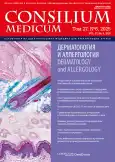Опыт применения бактериофагов энтеральной и гелевой формы в отношении пациента с акне. Клинический случай
- Авторы: Гладков С.Ф.1,2, Перевощикова Н.К.1, Леванова Л.А.1
-
Учреждения:
- ФГБОУ ВО «Кемеровский государственный медицинский университет» Минздрава России
- ООО «Клиника аллергологии и иммунологии»
- Выпуск: Том 27, № 6 (2025): Дерматология и аллергология
- Страницы: 344-347
- Раздел: Статьи
- URL: https://bakhtiniada.ru/2075-1753/article/view/309788
- DOI: https://doi.org/10.26442/20751753.2025.6.203234
- ID: 309788
Цитировать
Полный текст
Аннотация
Акне – полиэтиологический хронический дерматоз со сложным патогенезом, являющийся причиной развития физических, психических расстройств, приводящий в отдельных случаях к депрессии и социальной дезадаптации. Несмотря на широкий ассортимент медикаментов и доступность многочисленных методик, требующих в основном длительных сроков лечения, в большинстве случаев происходит снижение приверженности пациентов терапии. Под нашим наблюдением находилась пациентка с диагнозом «акне папуло-пустулезной формы» средней степени тяжести, осложненного региональным лимфаденитом, с анамнезом заболевания более 3 лет. Учитывая патофизиологию заболевания, основанную на характере формирования биопленок, основным направлением терапевтического подхода стало применение энтеральных и гелевых форм бактериофагов. Результатом проведения фаготерапии явилась полная ликвидация симптомов дерматоза.
Ключевые слова
Полный текст
Открыть статью на сайте журналаОб авторах
Сергей Федорович Гладков
ФГБОУ ВО «Кемеровский государственный медицинский университет» Минздрава России; ООО «Клиника аллергологии и иммунологии»
Автор, ответственный за переписку.
Email: doctor.gladkov@gmail.com
ORCID iD: 0000-0002-9088-7914
SPIN-код: 4756-0955
ассистент каф. поликлинической педиатрии, пропедевтики детских болезней и последипломной подготовки ФГБОУ ВО КемГМУ, рук. ООО «Клиника аллергологии и иммунологии»
Россия, Кемерово; ЮргаНина Константиновна Перевощикова
ФГБОУ ВО «Кемеровский государственный медицинский университет» Минздрава России
Email: doctor.gladkov@gmail.com
ORCID iD: 0000-0002-4571-7932
д-р мед. наук, проф., зав. каф. поликлинической педиатрии, пропедевтики детских болезней и последипломной подготовки
Россия, КемеровоЛюдмила Александровна Леванова
ФГБОУ ВО «Кемеровский государственный медицинский университет» Минздрава России
Email: doctor.gladkov@gmail.com
ORCID iD: 0000-0002-5977-9149
SPIN-код: 1052-9047
д-р мед. наук, доц., зав. каф. микробиологии и вирусологии
Россия, КемеровоСписок литературы
- Аравийская Е.Р., Мурашкин Н.Н., Намазова-Баранова Л.С., Иванов Р.А. Современные представления о патогенезе, особенностях клинической картины, диагностике и терапевтической тактике вульгарных акне у детей и подростков. Вопросы современной педиатрии. 2020;19(6):408-19 [Araviyskaya ER, Murashkin NN, Namazova-Baranova LS, Ivanov RA. Modern ideas about the pathogenesis, features of the clinical picture, diagnosis and therapeutic tactics of acne vulgaris in children and adolescents. Voprosy sovremennoi pediatrii. 2020;19(6):408-19 (in Russian)]. doi: 10.15690/vsp.v19i6.2141
- Аравийская Е.Р., Соколовский Е.В. Руководство по дерматокосметологии. СПб.: ФОЛИАНТ, 2008 [Araviyskaya ER, Sokolovsky E. Rukovodstvo po dermatokosmetologii. Saint Petersburg: FOLIANT, 2008 (in Russian)].
- Хализова К.А., Чеботарева Н.А. Гиперандрогения как причина развития стойкого, позднего и рецидивирующего акне. Научный лидер. 2023;35(133). [Khalizova KA, Chebotaryova NA. Hyperandrogenism as a cause of development of persistent, late and recurrent acne. Nauchnyi lider. 2023;35(133) (in Russian)].
- Тамразова О.Б., Тамразова А.В. Акне: мифы и реальность. Практика педиатра. 2021;4:51-6 [Tamrazova OB, Tamrazova AV. Acne: myths and reality. Pediatrician's Practice. 2021;4:51-6 (in Russian)].
- Bhat YJ, Latief I, Hassan I. Update on etiopathogenesis and treatment of Acne. Indian J Dermatol Venereol Leprol. 2017;83:298-306. doi: 10.4103/0378-6323.199581
- O’Neill AM, Gallo RL. Host-microbiome interactions and recent progress into understanding the biology of acne vulgaris. Microbiome. 2018;6:177. doi: 10.1186/s40168-018-0558-5
- Демина О.М., Румянцев А.Г., Потекаев Н.Н. Оценка роли полиморфных вариантов генов липидного обмена в патогенезе акне. Клиническая дерматология и венерология. 2023;22(4):418-24 [Demina OM, Rumyantsev AG, Potekaev NN. Evaluation of the role of polymorphic variants of lipid metabolism genes in the pathogenesis of acne. Klinicheskaya dermatologiya i venerologiya. 2023;22(4):418-24 (in Russian)]. doi: 10.17116/klinderma202322041418
- Oh J, Byrd AL, Deming C, Conlan S. NISC Comparative Sequencing Program, Kong HH, et al. Biogeography and individuality shape function in the human skin metagenome. Nature. 2014;514:59-64. doi: 10.1038/nature13786
- Zaenglein AL, Pathy AL, Schlosser BJ, et al. Guidelines of care for the management of acne vulgaris. J Am Acad Dermatol. 2016;74:945-73e33. doi: 10.1016/j.jaad.2015.12.037
- Bagatin E, Freitas THP, Rivitti-Machado MC, et al. Adult female acne: a guide to clinical practice. An Bras Dermatol. 2019;94(1):62-75. doi: 10.1590/abd1806-4841.20198203
- Berg G, Rybakova D, Fischer D, et al. Microbiome definition re-visited: old concepts and new challenges. Microbiome. 2020;8:103. doi: 10.1186/s40168-020-00875-0
- Baquero F, Nombela C. The microbiome as a human organ. Clin Microbiol Infect. 2012;18:2-4. doi: 10.1111/j.1469-0691.2012.03916.x
- Hadrich D. Microbiome research is becoming the key to better understanding health and nutrition. Front Genet. 2018;9:212. doi: 10.3389/fgene.2018.00212
- Ott SJ, Waetzig GH, Rehman A, et al. Efficacy of sterile fecal filtrate transfer for treating patients with clostridium difficile infection. Gastroenterology. 2017;152:799-811.e7. doi: 10.1053/j.gastro.2016.11.010
- Nakatsuji T, Chen TH, Narala S, et al. Antimicrobials from human skin commensal bacteria protect against Staphylococcus aureus and are deficient in atopic dermatitis. Sci Transl Med. 2017;9. doi: 10.1126/scitranslmed.aah4680
- Гладков С.Ф., Перевощикова Н.К., Пичугина Ю.С., Суркова М.А. Роль фаготерапии в моделировании микроэкосистемы кишечника. Медико-фармацевтический журнал «Пульс». 2020;22(12):183-91 [Gladkov SF, Perevoshchikova NK, Pichugina YS, Surkova MA. The role of phagotherapy in modeling the intestinal microecosystem. Medical & pharmaceutical journal “Pulse”. 2020;22(12):183-91 (in Russian)]. doi: 10.26787/nydha-2686-6838-2020-22-12-183-191
- Fitz-Gibbon S, Tomida S, Chiu B-H, et al. Propionibacterium acnes strain populations in the human skin microbiome associated with acne. J Invest Dermatol. 2013;133:2152-60. doi: 10.1038/jid.2013.21
- Liu J, Yan R, Zhong Q, et al. The diversity and host interactions of Propionibacterium acnes bacteriophages on human skin. ISME J. 2015;9:2078-93. doi: 10.1038/ismej.2015.47
- Jończyk-Matysiak E, Weber-Dąbrowska B, Żaczek M, et al. Prospects of phage application in the treatment of acne caused by Propionibacterium acnes. Front Microbiol. 2017;8. doi: 10.3389/fmicb.2017.00164








